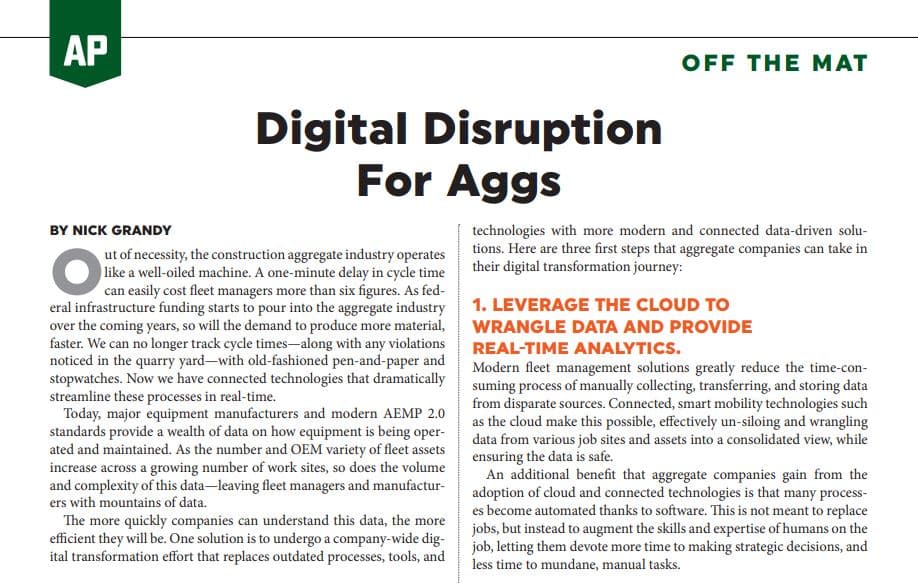Digital Disruption for Aggs
BY Nick Grandy

Out of necessity, the construction aggregate industry operates like a well-oiled machine. A one-minute delay in cycle time can easily cost fleet managers more than six figures. As federal infrastructure funding starts to pour into the aggregate industry over the coming years, so will the demand to produce more material, faster. We can no longer track cycle times—along with any violations noticed in the quarry yard—with old-fashioned pen-and-paper and stopwatches. Now we have connected technologies that dramatically streamline these processes in real-time.
Today, major equipment manufacturers and modern AEMP 2.0 standards provide a wealth of data on how equipment is being operated and maintained. As the number and OEM variety of fleet assets increase across a growing number of work sites, so does the volume and complexity of this data—leaving fleet managers and manufacturers with mountains of data.
The more quickly companies can understand this data, the more efficient they will be. One solution is to undergo a company-wide digital transformation effort that replaces outdated processes, tools, and technologies with more modern and connected data-driven solutions. Here are three first steps that aggregate companies can take in their digital transformation journey:
1. Leverage the cloud to wrangle data and provide real-time analytics.
Modern fleet management solutions greatly reduce the time-consuming process of manually collecting, transferring, and storing data from disparate sources. Connected, smart mobility technologies such as the cloud make this possible, effectively un-siloing and wrangling data from various job sites and assets into a consolidated view, while ensuring the data is safe.
An additional benefit that aggregate companies gain from the adoption of cloud and connected technologies is that many processes become automated thanks to software. This is not meant to replace jobs, but instead to augment the skills and expertise of humans on the job, letting them devote more time to making strategic decisions, and less time to mundane, manual tasks.
2. Digitalize maintenance tools to limit preventable violations.
With modern technologies, such as artificial intelligence and machine learning, maintenance becomes less reactive and more predictive and preventive, by providing operators with forward-thinking insight into diagnostic information that can be easily understood as a digital health score.
3. Modernize inspections and improve communication with connected devices.
Connected tablets and devices enable operators to manage tasks by the hour with full visibility into the operation, at their fingertips. In-cab tablets allow drivers to complete time, date, and location-verified pre- and post-trip inspections, while receiving detailed directions for each route. They are also a powerful communication tool for the coordination of unexpected changes.
And as the company grows, the integration of IoT-connected devices into smart mobility management solutions provides even more valuable telemetry outside the onboard data generated by your assets. These types of devices include wearables, drones, cameras, various types of sensors, and other positioning systems.
The future of construction and aggregate site operations is in leveraging better data trends and technologies that are designed to improve the speed of production and growth of the business—while ensuring best practice safety and environmental conditions are met.
Nick Grandy is the GM, Vocational—Industrial Services at Zonar.
